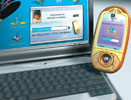

NFC (near field communication) is a very short-range wireless technology for distances measured in centimetres, and is optimised for intuitive, easy and secure communications between various devices without user configuration. In order to make two devices communicate, users bring them close together or even make them touch. The devices' NFC interfaces will automatically connect and configure themselves to form a peer-to-peer network. NFC can also bootstrap other protocols like Bluetooth or Wireless Ethernet (WiFi) by exchanging the configuration and session data.
Smartcard compatibility
NFC is compatible with Philips' MIFARE and Sony's Felica contactless smartcard platforms. This enables NFC devices to read information from these cards, making contactless smartcards the ideal solution for bringing information and vouchers into the NFC world. NFC devices can also operate like a contactless card - even when switched off - making them compatible with the huge installed infrastructure of MIFARE and Felica systems. These proven systems, with millions of cards in the market already, provide a solid foundation for the introduction of NFC enabled devices.
Secure NFC
Secure NFC combines NFC applications with smartcard security. Devices with secure NFC act like a contactless smartcard with cryptographic capabilities. This means that confidential data and data that represents values is stored in a secure memory area and always stays on the card. Authentication is performed by the NFC device itself and transmitted data can be encrypted by the NFC device using a private encryption key stored in the device's secure memory.
Active or passive operation
NFC-enabled devices can operate in active or passive modes. Mobile devices operating primarily in passive mode can achieve significant power savings, stretching precious battery time. Active NFC devices can supply all the power needed for communication with passive devices through their internally-generated RF field - in exactly the same way contactless smartcards are powered - ensuring that data remains accessible even when the mobile device is switched off.
Standardisation
NFC is an open platform technology standardised in ECMA 340 as well as ETSI TS 102 190 V1.1.1 and ISO/IEC 18092. These standards specify the modulation schemes, coding, transfer speeds, and frame format of the RF interface of NFC devices, as well as initialisation schemes and conditions required for data collision-control during initialisation - for both passive and active NFC modes. Furthermore, they also define the transport protocol, including protocol activation and data exchange methods.
In order to further compatibility and interoperability between devices, Philips, Nokia and Sony have founded the NFC Forum (www.nfc-forum.org) and invite other interested parties to join.
For more information contact Rodney Farrow, Arrow Altech Distribution, +27 (0)11 923 9600, [email protected]
| Tel: | +27 11 923 9600 |
| Email: | [email protected] |
| www: | www.altronarrow.com |
| Articles: | More information and articles about Altron Arrow |

© Technews Publishing (Pty) Ltd | All Rights Reserved